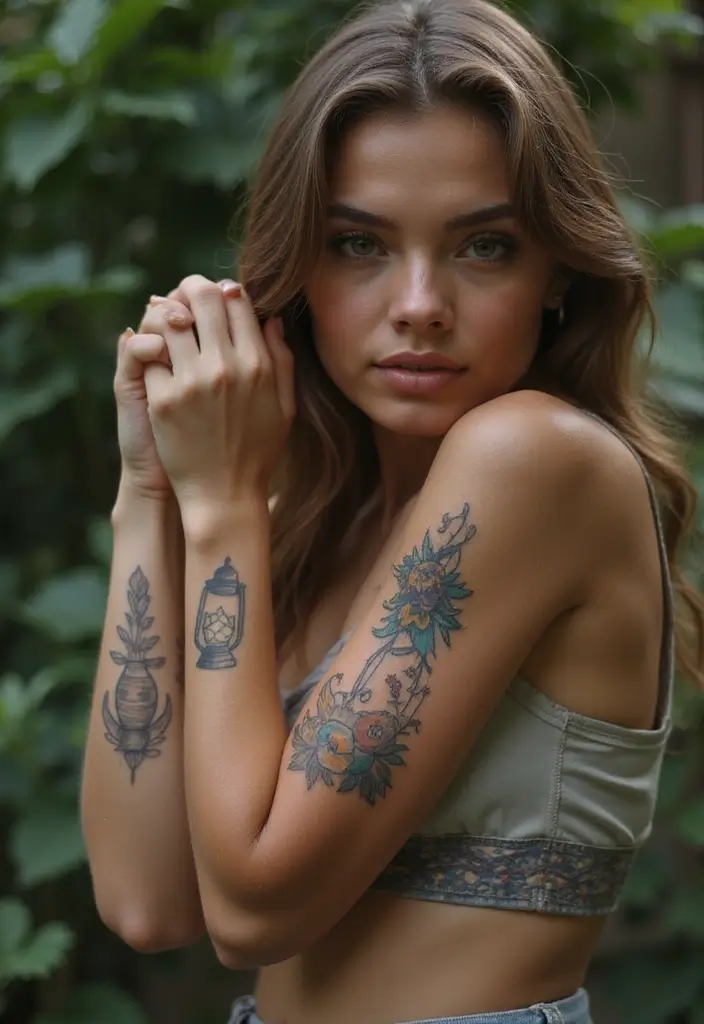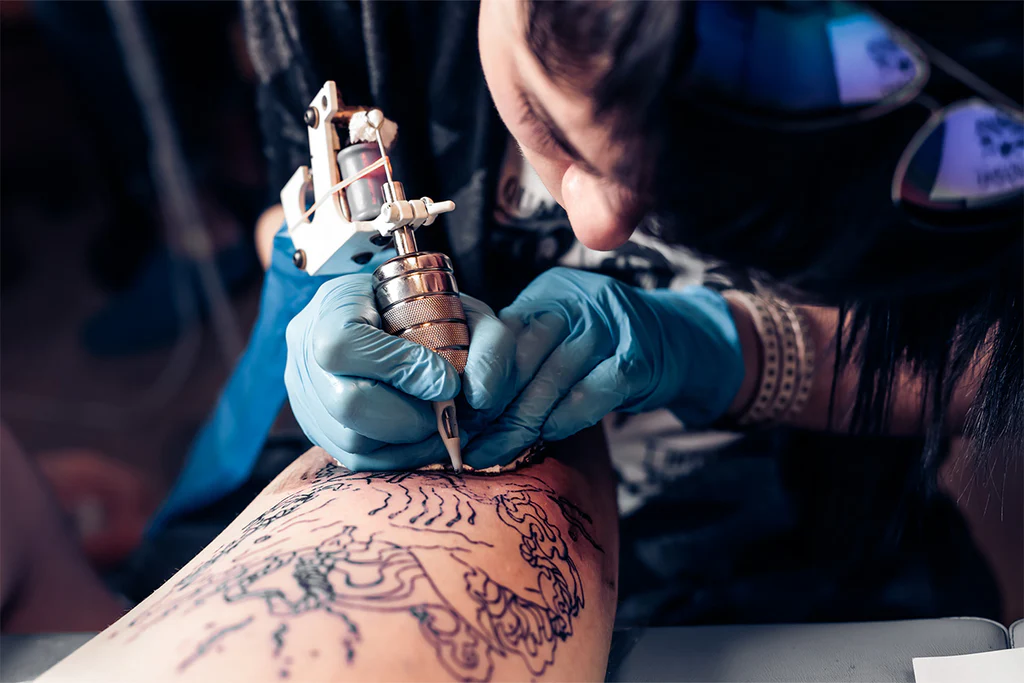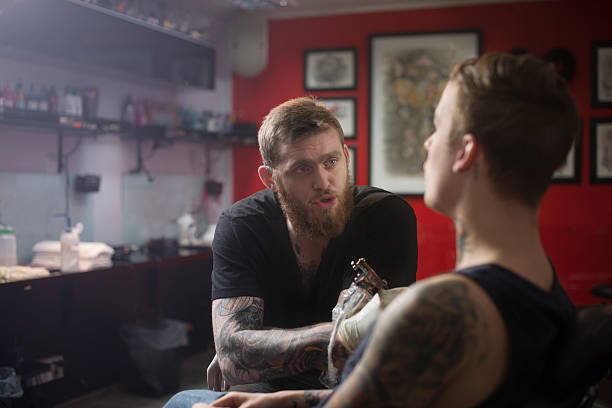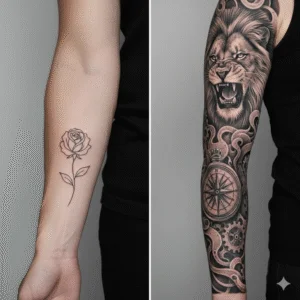Imagine the power and mystique of ancient Japanese mythology permanently etched onto your skin. Japanese dragon tattoos aren’t just body art—they’re powerful symbols steeped in centuries of cultural significance, representing strength, wisdom, and good fortune.
Unlike their Western counterparts, Japanese dragons (or “ryū”) embody benevolence and protection rather than malevolence. When you choose this iconic design, you’re connecting with a tradition that dates back to ancient times, yet remains stunningly relevant in modern tattoo artistry. From full back pieces to sleeves or smaller accents, these magnificent creatures can be adapted to suit your personal style while maintaining their authentic symbolism.
The Symbolic Meaning of Japanese Dragon Tattoos
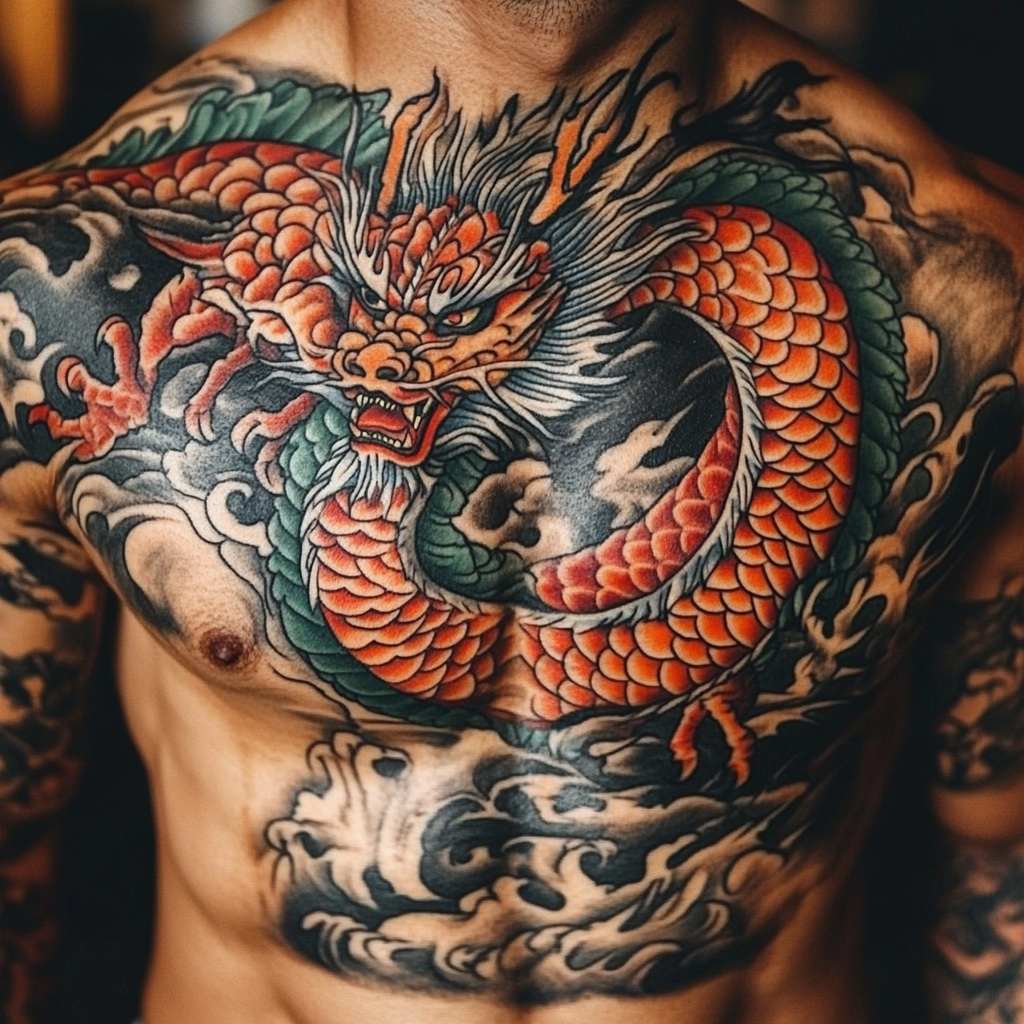
1. Wisdom and Intelligence
Japanese dragon tattoos symbolize profound wisdom and intelligence. Unlike their Western counterparts, these mythical creatures represent enlightenment and knowledge gained through experience. Your dragon tattoo can serve as a reminder of your personal growth journey and intellectual pursuits. Many Japanese tales depict dragons as sage advisors to emperors and deities, making this symbol perfect if you value knowledge and thoughtful decision-making.
2. Strength and Power
Dragon tattoos in Japanese culture embody immense physical and spiritual strength. These creatures control the elements, particularly water, demonstrating their command over powerful forces. Your dragon tattoo can represent your inner strength, resilience, and ability to overcome life’s challenges. Many women choose this design to symbolize their personal power and determination when facing obstacles.
3. Good Fortune and Prosperity
Japanese dragons bring good luck and abundance to those they favor. Your dragon tattoo can attract positive energy and fortunate circumstances into your life. Traditional Japanese art often shows dragons clutching or protecting the sacred pearl, which represents wealth, success, and good fortune. This makes dragon tattoos particularly meaningful if you’re entering a new chapter in life or seeking positive change.
4. Protection and Guardianship
Dragons in Japanese mythology serve as protective guardians of precious treasures and sacred places. Your dragon tattoo can symbolize your protective nature toward loved ones or represent spiritual guardianship. Many women choose dragon designs that appear to wrap around their body, creating a sense of being guarded by this powerful creature against negative energies and harmful influences.
5. Transformation and Change
Japanese dragons possess the ability to change form, symbolizing transformation and personal evolution. Your dragon tattoo can represent important life changes you’ve experienced or your adaptability in different situations. Dragons are often depicted moving between water and sky, embodying the transition between different states of being. This symbolism resonates particularly with women who have overcome important challenges or reinvented themselves.
6. Balance of Elements
Japanese dragons represent the perfect balance between opposing forces. Your dragon tattoo can symbolize your ability to maintain harmony in your life and relationships. These creatures command water while flying through air and breathing fire, demonstrating mastery of multiple elements. This balance makes dragon tattoos meaningful for those who strive to integrate different aspects of their personality or seek equilibrium in their busy lives.
7. Divine Connection and Spirituality
In Japanese traditions, dragons serve as messengers between humans and higher powers. Your dragon tattoo can represent your spiritual journey and connection to something greater than yourself. These mythical beings often appear in religious iconography, linking the earthly and divine realms. Many women choose dragon tattoos to symbolize their spiritual awakening or ongoing search for deeper meaning in life.
8. Longevity and Immortality
Japanese dragons are associated with eternal life and longevity. Your dragon tattoo can symbolize your desire for a long, healthy life or represent the immortality of your spirit or ideas. Traditional imagery often shows dragons with the sacred pearl of immortality, reinforcing this powerful symbolism. This meaning resonates with those who wish to leave a lasting legacy or honor the enduring nature of important relationships.
Traditional vs. Modern Japanese Dragon Tattoo Styles
Irezumi: The Ancient Art of Japanese Tattooing

Traditional Japanese dragon tattoos, known as Irezumi, follow exact artistic conventions that have been perfected over centuries. These classic designs feature bold, black outlines with vibrant colors that create dramatic contrast. Traditional dragons typically appear with pronounced scales, fierce expressions, and flowing beards, often surrounded by complementary elements like clouds, waves, or cherry blossoms. The composition usually follows traditional body placement rules, with designs that work harmoniously with the body’s natural contours. Artists trained in Irezumi use techniques passed down through generations, including the tebori method of hand-poking tattoos, which creates distinctive texture and depth unachievable with modern machines.
Contemporary Interpretations of Dragon Imagery

Modern Japanese dragon tattoo styles blend traditional symbolism with fresh artistic approaches. Today’s artists often incorporate realistic shading techniques, creating three-dimensional dragons that seem to leap off the skin. Many contemporary designs feature minimalist interpretations with clean lines and negative space, offering a subtler alternative to traditional full-color pieces. Fusion styles combine Japanese dragons with other tattoo genres like watercolor, geometric patterns, or blackwork for truly unique pieces. Digital-age innovations have expanded color palettes beyond traditional reds and blues to include vibrant purples, teals, and even UV-reactive inks. Modern artists frequently break from rigid composition rules, creating abstract or deconstructed dragons that maintain symbolic meaning while pushing artistic boundaries.
Popular Placements for Japanese Dragon Tattoos
Japanese dragon tattoos can be adapted to various body locations, each offering unique advantages for showcasing these majestic mythical creatures. The placement you choose will significantly impact how the design flows and how much detail can be incorporated.
Full Back Dragon Designs
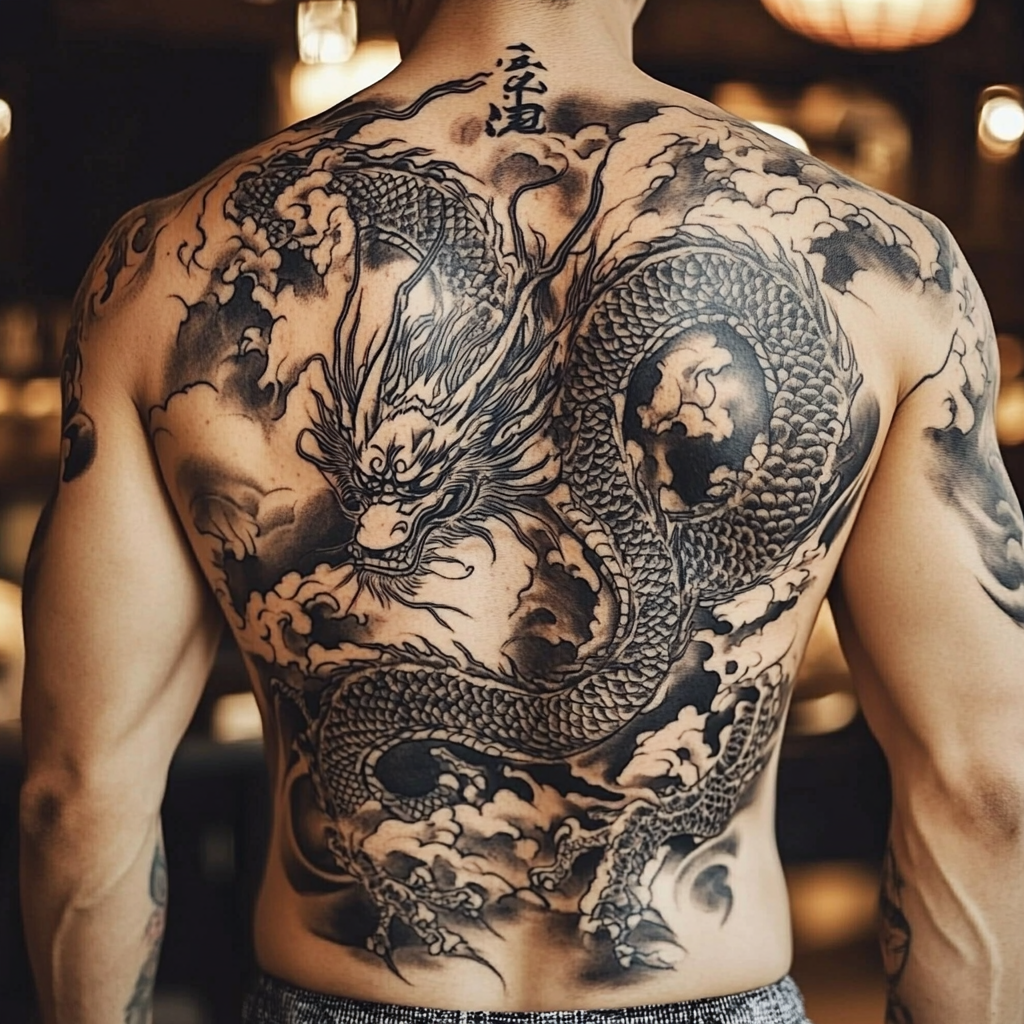
Full back placements provide the ultimate canvas for elaborate Japanese dragon tattoos. This expansive area allows for:
- Complete dragon portrayal with all traditional elements such as clouds, waves, and sacred pearls intact
- Natural body contour integration that follows the curve of your spine and shoulder blades
- Storytelling potential where the dragon can be depicted in ever-changing poses like ascending to heaven or coiling through stormy skies
- Maximum impact visibility when revealed, making a powerful artistic statement
- Scale detail preservation where every intricate scale and facial feature can be rendered with precision
The back offers enough space for artists to create dramatic scenes with dragons interacting with other mythological figures like phoenix or tiger counterparts. These designs typically require multiple sessions spanning several months but result in breathtaking pieces that serve as the centerpiece of any tattoo collection.
Sleeve and Chest Placements
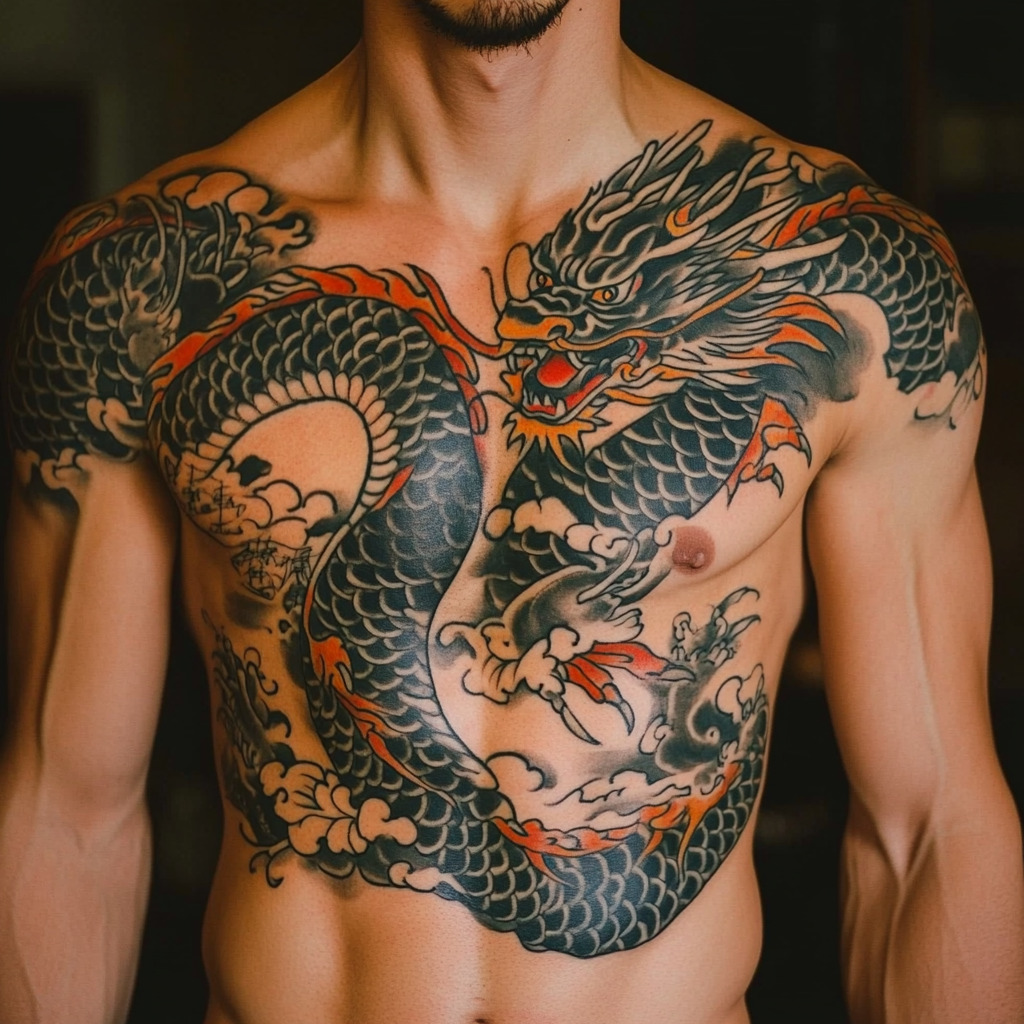
Sleeve and chest placements create striking dragon designs that can be prominently displayed or easily concealed:
- Flowing arm designs where dragons spiral around your bicep, forearm, and shoulder in continuous motion
- Half-sleeve options featuring a dragon head on the shoulder cascading down to the elbow
- Chest panels that position the dragon’s face prominently while its body extends across your pectoral area
- Combined chest-to-sleeve pieces allowing the dragon to flow naturally from your torso to your arm
- Wrap-around formations creating a three-dimensional effect as the dragon encircles your limb
These placements work particularly well for showcasing the dragon’s sinuous body in motion. Many enthusiasts choose to incorporate traditional background elements like wind bars, cherry blossoms, or water patterns to enhance the authentic Japanese aesthetic and provide context for the dragon’s movement.
Smaller Dragon Tattoo Options
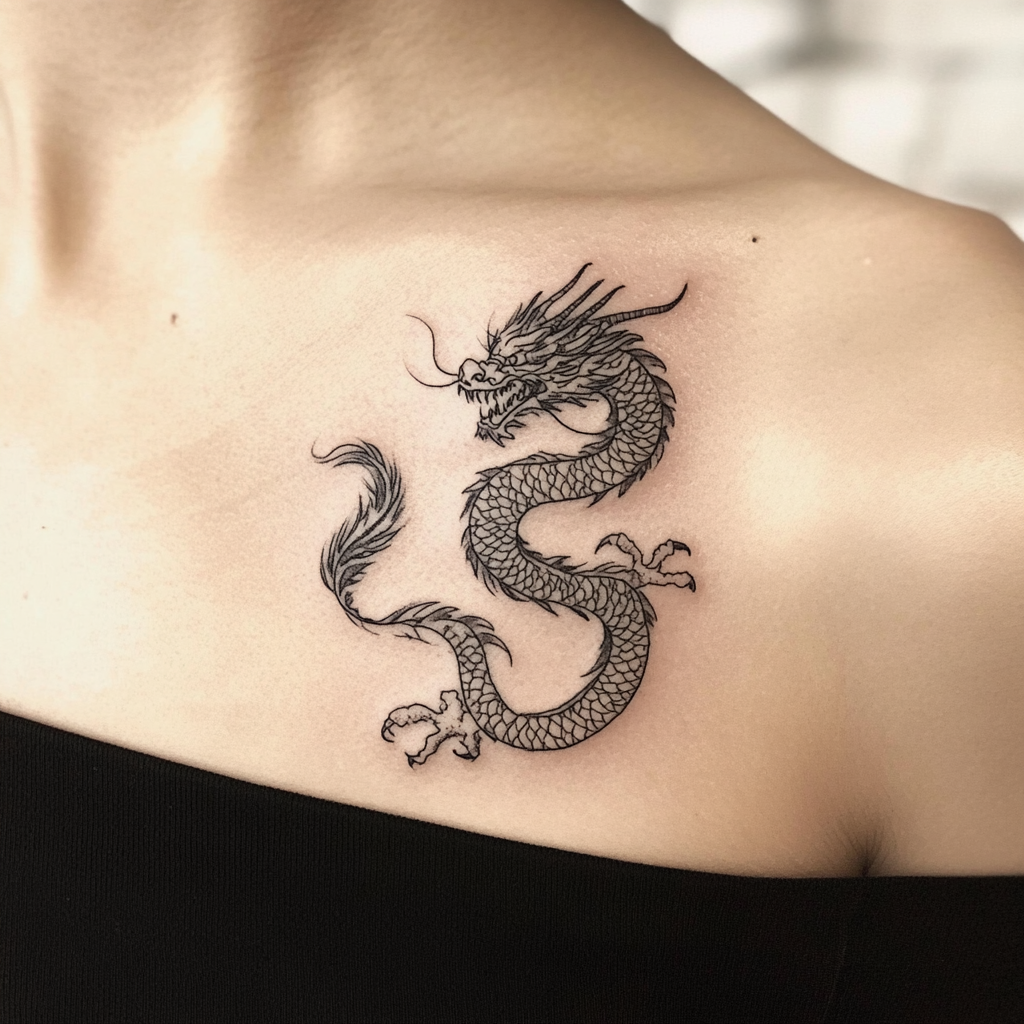
Not all Japanese dragon tattoos require extensive coverage. These smaller options deliver powerful symbolism in more compact forms:
- Forearm dragon bands that encircle your wrist or forearm with simplified dragon motifs
- Shoulder cap designs featuring a coiled dragon that fits perfectly atop your shoulder
- Upper back/neck dragons that peek out from collar lines for subtle yet meaningful placement
- Side torso pieces where the dragon follows your natural rib contours
- Calf or thigh dragons that can be sized to suit your preference while maintaining traditional details
Small dragon tattoos often focus on distinctive elements like the dragon’s head or a coiled position rather than the entire body. These condensed designs can still incorporate traditional Japanese stylistic elements like bold outlines and strategic color placement while requiring less commitment in terms of pain, time, and visibility than their larger counterparts.
Color Choices in Japanese Dragon Tattoos
The colors used in your Japanese dragon tattoo aren’t just aesthetic choices—they carry exact cultural meanings and visual impact that can transform the artwork’s symbolism.
Traditional Black and Gray

Traditional black and gray Japanese dragon tattoos offer timeless elegance with deep cultural significance. These monochromatic designs highlight the intricate details of scales, claws, and facial expressions through expert shading techniques. Black and gray dragons convey:
- Sophistication and subtlety that allows the dragon’s form and movement to take center stage
- Versatility across skin tones, making this palette universally flattering
- Faster healing time compared to colored tattoos as they require less ink saturation
- Lower maintenance with minimal color fading over time, requiring fewer touch-ups
- Traditional reverence, as early Japanese tattoo artists worked primarily with black ink before colored pigments became widely available
The contrast between deep blacks and lighter gray washes creates dimension that brings your dragon to life, emphasizing the mythical creature’s powerful presence while maintaining a classic aesthetic.
Vibrant Color Combinations
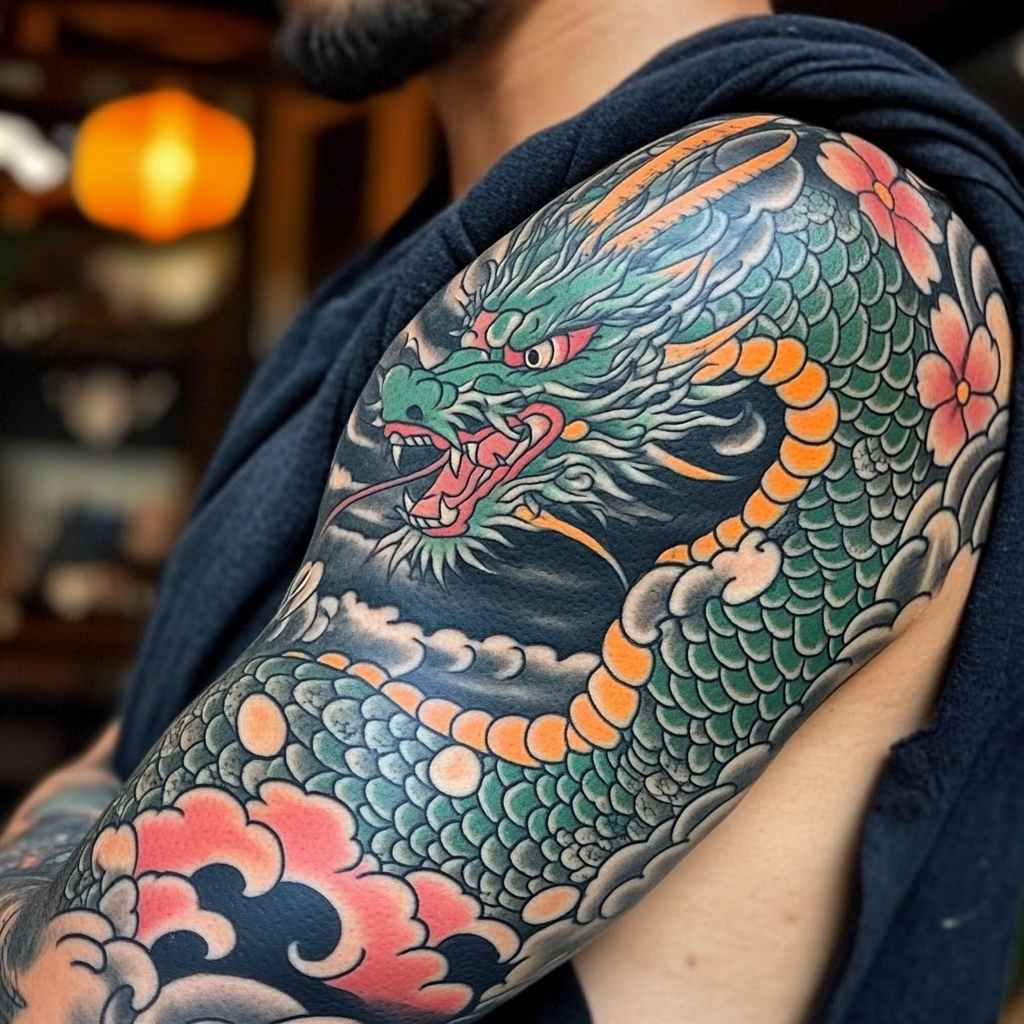
Vibrant color combinations in Japanese dragon tattoos breathe ever-changing energy into your design. Traditional Japanese tattooing employs a distinctive color palette that includes:
- Bright blues representing water elements and the dragon’s connection to rivers and seas
- Emerald greens symbolizing growth, harmony, and the dragon’s association with nature
- Deep purples conveying nobility, mystery, and spiritual wisdom
- Vibrant oranges depicting energy, enthusiasm, and the dragon’s fiery spirit
- Contrasting yellow accents highlighting details like eyes, horns, or spiritual orbs
These colorful designs typically feature bold black outlines to create definition between the vibrant hues. Many tattoo artists blend these colors in ways that make the dragon appear to move across your skin, creating a three-dimensional effect that makes your tattoo truly pop.
Gold and Red Dragon Symbolism
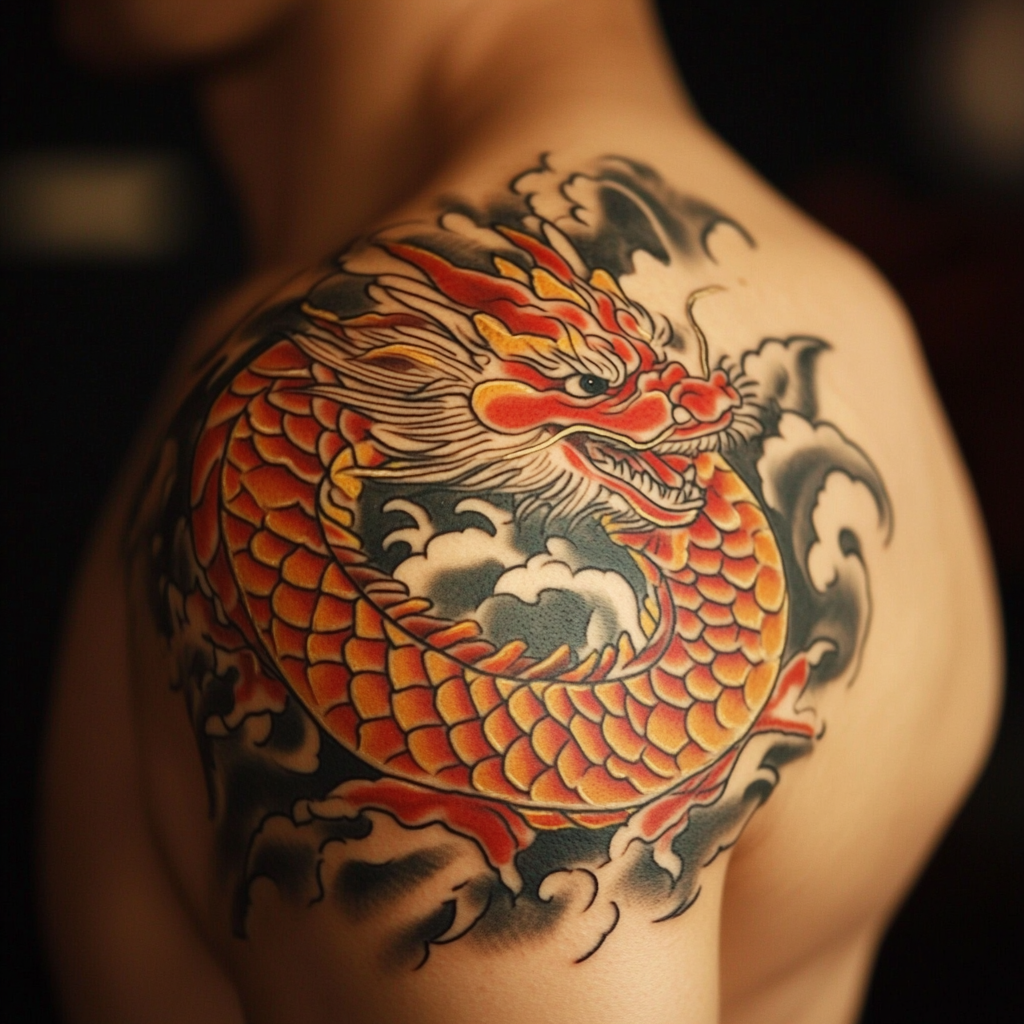
Gold and red Japanese dragon tattoos carry the strongest symbolic weight in traditional Japanese culture. This powerful color combination is deeply rooted in cultural significance:
- Red dragons represent extreme passion, protection, and good fortune
- Gold elements symbolize wealth, prosperity, and divine connection
- Red and gold together create an imperial aesthetic associated with royalty and power
- Culturally important pairing seen in Japanese temples, shrines, and historical artwork
- Maximum visual impact that draws attention and makes a bold statement
The vibrant red scales contrasted with gold accents like claws, horns, or the pearl often clutched in the dragon’s claw creates a stunning visual that embodies good fortune. This combination is particularly favored for larger pieces where the rich colors can flow across broader areas of skin, creating a truly majestic appearance that honors the dragon’s status as a revered mythological being.
Elements That Complement Japanese Dragon Tattoos
Clouds and Water Motifs
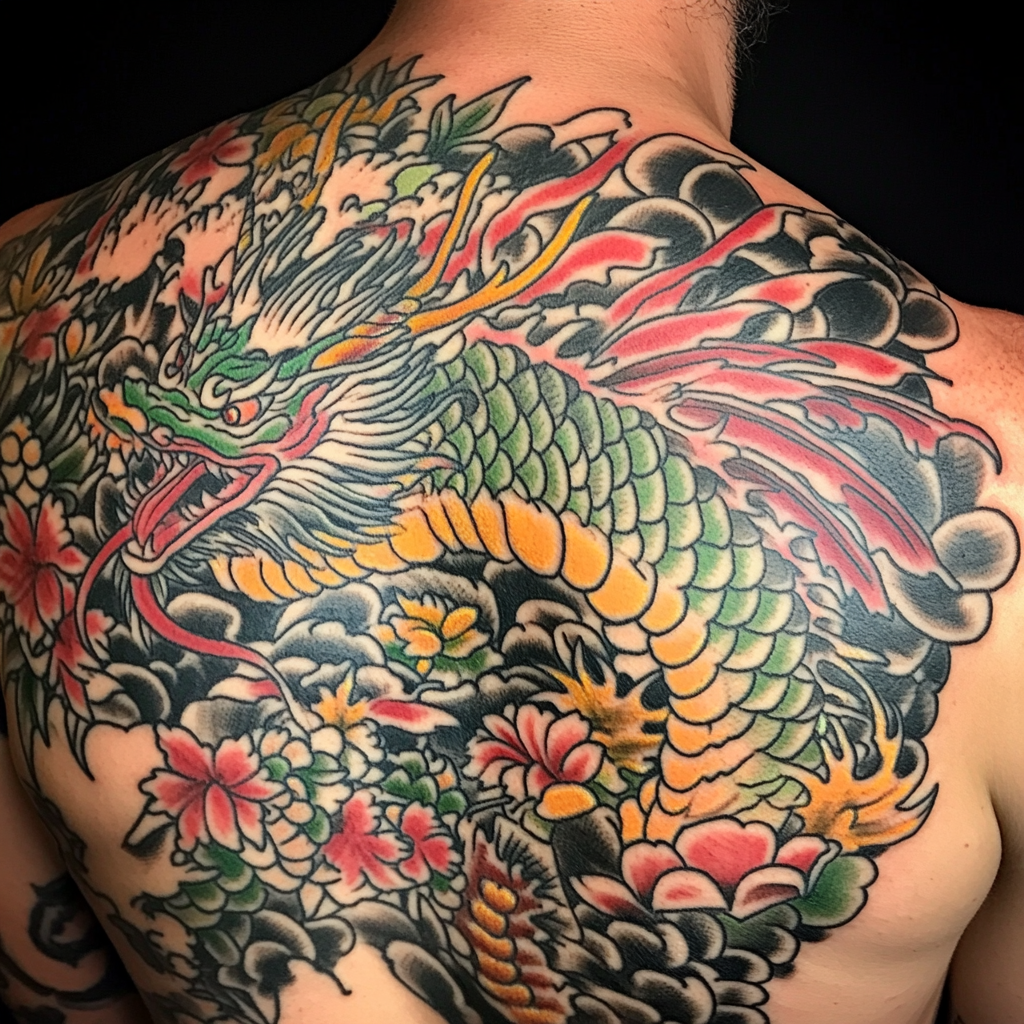
Clouds and water elements enhance Japanese dragon tattoos by creating a ever-changing sense of movement and natural environment. Traditional Japanese dragons are often depicted swimming through clouds or emerging from turbulent waters, symbolizing their connection to these elements. Adding swirling cloud patterns around your dragon creates depth and a dreamlike quality, making the mythical creature appear to be soaring through the heavens. Water motifs, particularly stylized waves like the iconic Hokusai-inspired designs, represent the dragon’s association with rainfall and bodies of water in Japanese mythology. These complementary elements not only provide visual context but also reinforce the dragon’s role as a water deity that controls rain, rivers, and seas.
Cherry Blossoms and Other Florals
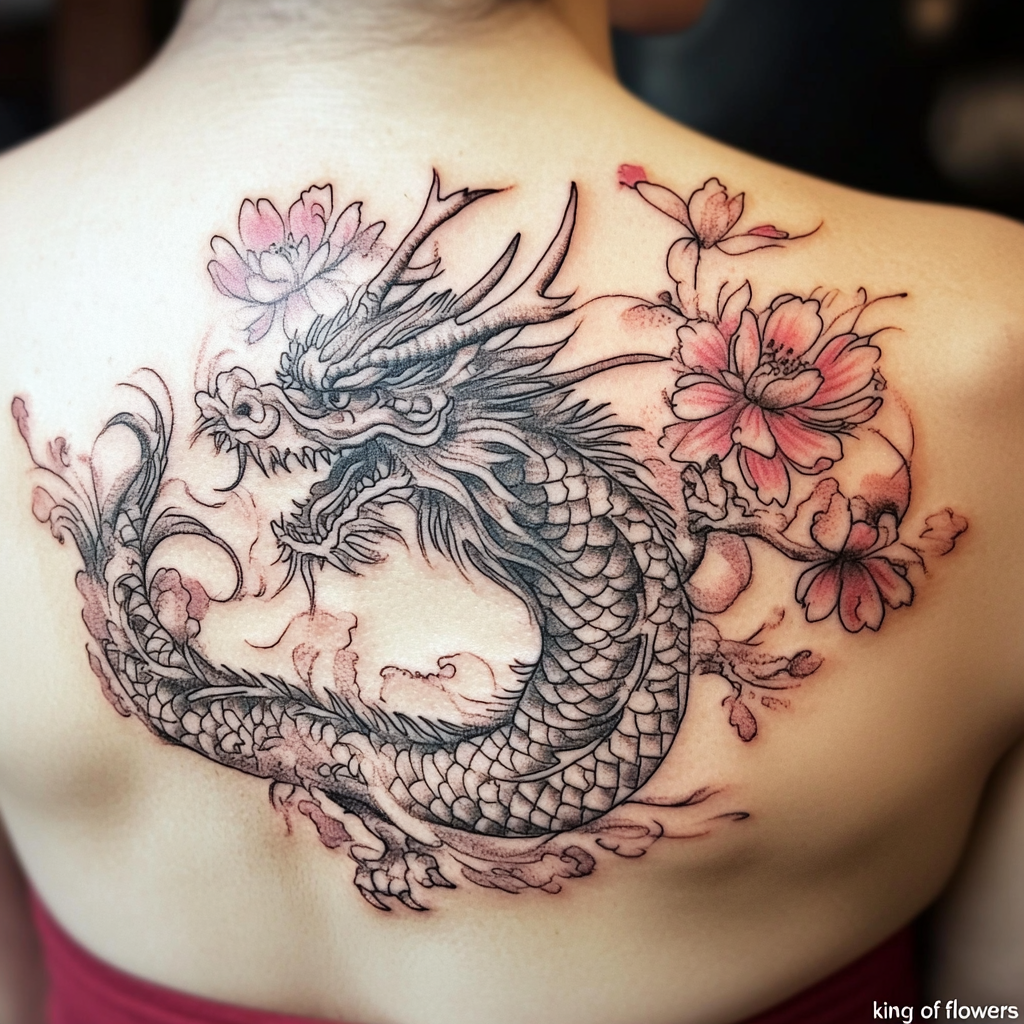
Cherry blossoms (sakura) pair beautifully with Japanese dragon tattoos, creating a striking contrast between power and delicacy. These iconic flowers symbolize the ephemeral nature of life and beauty in Japanese culture, adding philosophical depth to your dragon design. Peonies, known as the “king of flowers” in Japan, represent prosperity and good fortune when incorporated alongside dragons. Lotus flowers introduce a spiritual dimension, symbolizing enlightenment and purity emerging from murky waters. Chrysanthemums, Japan’s imperial flower, bring themes of longevity and perfection. These floral elements soften the dragon’s fierce appearance while maintaining cultural authenticity, creating a harmonious balance between strength and beauty that resonates deeply within Japanese artistic traditions.
Mythological Creatures and Deities
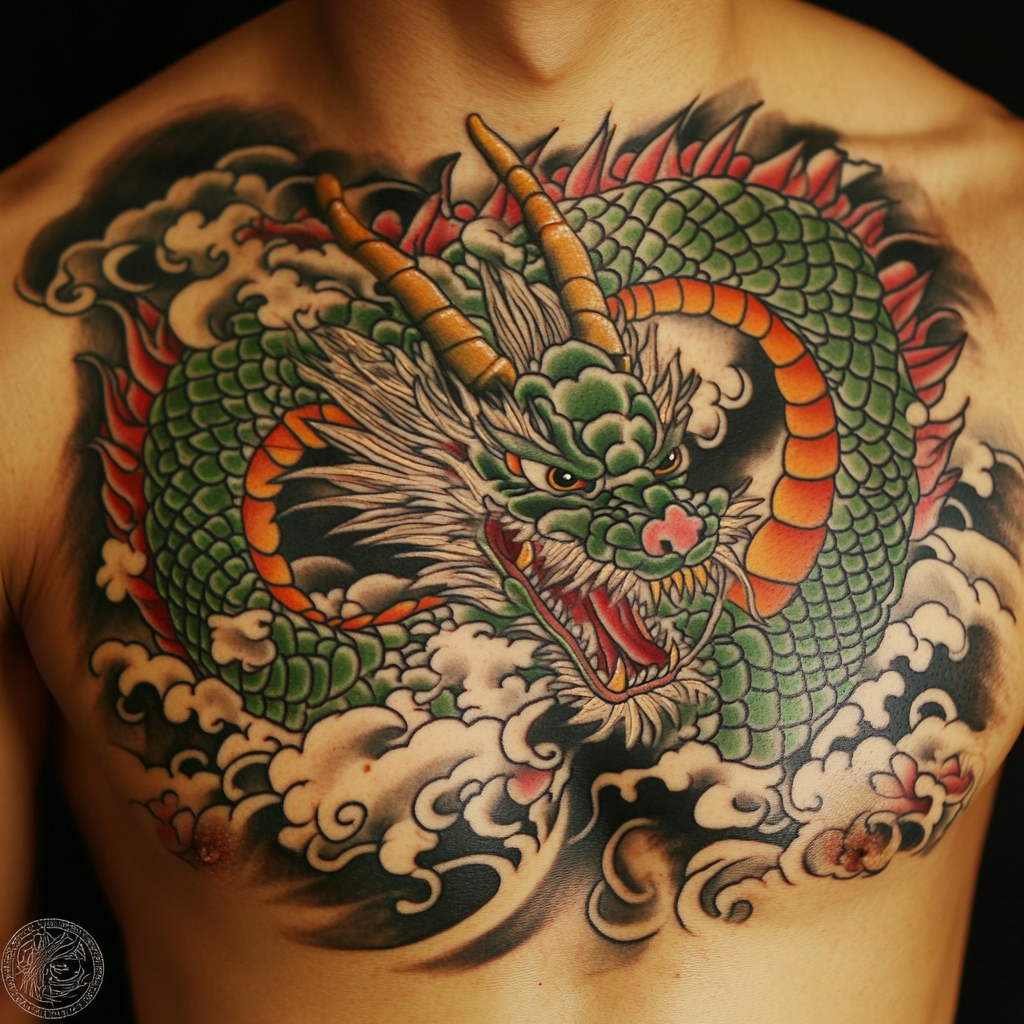
Pairing your Japanese dragon tattoo with other mythological beings creates a rich narrative tapestry steeped in traditional symbolism. The phoenix (Hō-ō) makes an excellent companion to dragons, representing the balance of opposing forces—fire and water, heaven and earth. Koi fish designs alongside dragons tell the story of transformation and perseverance, referencing the legend of the koi that swam upstream to become a dragon. Tigers create a classic dualism when paired with dragons, symbolizing the balance between earthly power (tiger) and heavenly might (dragon). Guardian creatures like shishi (lion dogs) or oni (demons) add protective qualities to your design. Including deities such as Fudō Myōō (deity of fire) or Benzaiten (goddess of everything that flows) creates a spiritually potent composition that honors the complex pantheon of Japanese mythology while making your tattoo uniquely meaningful.
Famous Japanese Dragon Tattoo Artists to Follow
Horiyoshi III (Yoshihito Nakano)
Horiyoshi III stands as a living legend in the industry of traditional Japanese tattooing. Based in Yokohama, he’s dedicated over 40 years to perfecting the art of irezumi, with his dragon designs being particularly revered for their fluid movement and traditional authenticity. His dragons breathe life through meticulous scale work and ever-changing compositions that follow the body’s natural contours. You’ll notice his distinctive style through his perfect balance of negative space and bold color choices that make dragons appear almost three-dimensional.
Henning Jorgensen
As the founder of Royal Tattoo in Denmark, Henning Jorgensen has become one of the most influential Japanese-style tattoo artists outside Japan. His dragon tattoos combine traditional Japanese techniques with Danish precision, creating uniquely powerful interpretations that respect cultural origins while adding his personal touch. You’ll find his work characterized by exceptionally clean lines and vivid color saturation that brings mythical dragons to striking reality on skin.
Shige (Shigenori Iwasaki)
Shige’s dragon tattoos transcend conventional boundaries with their dreamlike quality and technical perfection. Working from his studio Yellow Blaze in Yokohama, he creates dragons that seem to emerge from another dimension with their ethereal coloring and supernatural movement. You’ll recognize his signature style through his innovative use of light and shadow that gives his dragons an almost luminous quality, making them appear to glow from within the skin.
Horitomo (Kazuaki Kitamura)
Horitomo blends traditional Japanese tattooing with his background in fine art to create dragons that honor historical conventions while pushing artistic boundaries. Based at State of Grace in San Jose, his dragons display exceptional attention to anatomical details and mythological accuracy. You’ll appreciate his technical precision in tebori (hand-poked) tattooing, which gives his dragon scales a textured dimension that machine work simply cannot replicate.
Mike Rubendall
Owner of Kings Avenue Tattoo in New York, Mike Rubendall has earned worldwide recognition for his Japanese-inspired work, particularly his ever-changing dragon designs. His dragons possess an unmistakable intensity through powerful color contrasts and dramatic poses that capture the creature’s legendary strength. You’ll find his work distinguished by exceptionally bold outlines and revolutionary color blending techniques that give his dragons remarkable depth and dimension.
Horikazu II (Takuji Matsuda)
Carrying on the legacy of his master, Horikazu II creates dragons that embody the purest traditional Japanese aesthetics with unwavering dedication to historical techniques. Working in Tokyo, his dragons showcase classically balanced compositions with meticulous attention to flow and movement across the body. You’ll notice his distinctive approach through his subdued yet rich color palette that gives his dragons an authentic, timeless quality reminiscent of Edo-period artwork.
Chris O’Donnell
At Kings Avenue Tattoo, Chris O’Donnell has established himself as a master of Japanese dragon imagery with his distinctively powerful interpretations. His dragons command attention through their bold presence and dramatic positioning, often incorporating traditional elements like wind bars and water motifs. You’ll identify his work through his expert use of negative space and strategic placement that maximizes visual impact while honoring the body’s natural lines.
Jess Yen
Founder of My Tattoo in California, Jess Yen creates magnificent dragon tattoos that balance traditional symbolism with contemporary execution. His dragons display exceptional dynamism through sweeping compositions that create a sense of continuous movement across large body areas. You’ll recognize his distinctive style through his rich, saturated color work and the remarkable level of detail he achieves in scales, claws, and facial expressions that give each dragon individual character.
Horizakura (Takashi Matsuba)
Working in New York City, Horizakura creates dragons with a distinctly traditional Japanese aesthetic while working entirely in black and gray. His minimalist approach showcases the power of restraint, with dragons that convey immense energy through expert linework and tonal variations. You’ll find his work characterized by exceptional control of shadow and light that creates dramatic dimension without relying on color, proving that simplicity often carries the strongest impact.
Filip Leu
Based in Switzerland, Filip Leu brings his family’s artistic legacy to Japanese dragon tattooing with revolutionary compositions that push traditional boundaries. His dragons exhibit extraordinary movement through spiraling, swirling designs that seem to defy the limitations of skin as a canvas. You’ll spot his unique approach through his experimental color transitions and lightning-fast technical execution that results in dragons with unparalleled fluidity and energy.
How to Choose the Right Japanese Dragon Design for You
Your Japanese dragon tattoo will become a permanent part of your story and personal mythology. As you embark on this artistic journey consider both the aesthetic appeal and deeper meaning behind your design.
Take time to research artists who specialize in Japanese tattooing and don’t rush the decision. The right dragon tattoo should resonate with your personal values while honoring this ancient art form’s rich traditions.
Whether you choose a bold full-back masterpiece or a subtle forearm design your Japanese dragon tattoo will serve as more than decoration. It’s a powerful symbol that connects you to centuries of cultural significance while expressing your individual strength transformation and aspirations.
Frequently Asked Questions
What symbolism do Japanese dragon tattoos carry?
Japanese dragon tattoos symbolize strength, wisdom, and good fortune—unlike Western dragons often portrayed as evil. They represent personal growth, resilience, prosperity, and protection. These mythical creatures embody transformation and balance between opposing forces, while also signifying divine connection, longevity, and immortality. Each dragon tattoo serves as a powerful reminder of one’s journey and aspirations.
How do traditional and modern Japanese dragon tattoo styles differ?
Traditional Irezumi styles feature bold outlines, vibrant colors, and body-conforming designs created through techniques like tebori (hand-poking). Modern interpretations blend traditional symbolism with innovative approaches including realistic shading, minimalist designs, and fusion styles. Contemporary artists experiment with expanded color palettes and abstract compositions while maintaining the dragon’s essential symbolic meaning.
What are popular placements for Japanese dragon tattoos?
Full back pieces allow for elaborate, detailed dragons with traditional elements. Sleeve and chest placements create striking visuals that can be displayed or concealed as needed. Smaller dragon tattoos on forearms or shoulders maintain traditional styling with less commitment. The placement should enhance the design’s flow and complement the body’s natural contours.
What colors are significant in Japanese dragon tattoos?
Colors carry specific cultural meanings in Japanese dragon tattoos. Black and gray designs offer elegance and versatility. Vibrant color combinations add energy and dimension. Gold represents prosperity and divinity, while red symbolizes passion, protection, and good fortune. Color choices impact both the visual appeal and symbolic meaning of the tattoo.
What elements complement Japanese dragon tattoos?
Clouds and water motifs enhance movement and the dragon’s connection to nature. Cherry blossoms, peonies, and lotus flowers balance strength with beauty, adding philosophical depth. Pairing dragons with other mythological creatures like phoenixes, koi fish, or tigers enriches the narrative and symbolism, creating more complex visual stories with deeper cultural significance.
Who are some notable Japanese dragon tattoo artists?
Renowned artists include Horiyoshi III (fluid movement), Henning Jorgensen (Japanese-Danish fusion), Shige (dreamlike aesthetics), Horitomo (traditional-fine art blend), Mike Rubendall (powerful color contrasts), Horikazu II (classic style), Chris O’Donnell (bold interpretations), Jess Yen (dynamic compositions), Horizakura (minimalist approach), and Filip Leu (revolutionary designs). Each brings unique perspectives to the art form.
How should I care for a large Japanese dragon tattoo?
Follow a healing timeline with daily cleaning using mild soap and water. Avoid sun exposure and prevent infection during healing. For long-term care, moisturize daily and schedule touch-ups to maintain vibrancy. Consider sleep positioning and clothing choices to manage large-scale healing. Regular follow-ups with your artist ensure proper healing and preserve the authentic Japanese aesthetic.
Are Japanese dragon tattoos different from Chinese dragon tattoos?
Yes. Japanese dragons (ryū) typically have three toes, sleeker bodies, and more serpentine forms compared to Chinese dragons with five toes and bulkier physiques. Japanese dragon tattoos often incorporate specific cultural elements like sakura or waves, while Chinese dragons may appear with different complementary symbols. The artistic styles and color applications also differ between these traditions.
How painful are Japanese dragon tattoos?
Pain levels vary based on placement, size, and individual pain tolerance. Areas with thin skin over bone (ribs, spine, feet) tend to be more painful than fleshier regions. Large Japanese dragon tattoos requiring multiple sessions can be physically demanding. Traditional tebori hand-poking techniques may cause different sensations than machine tattooing. Consult with your artist about pain management strategies.
How much do Japanese dragon tattoos typically cost?
Japanese dragon tattoos range from $800-$1,500 for medium-sized pieces to $7,000+ for full back or body suit designs. Pricing depends on the artist’s expertise, session length (typically $150-$250 per hour), complexity, colors used, and geographic location. Traditional masters with extensive training often command premium rates. Most large pieces require multiple sessions spread over months.


